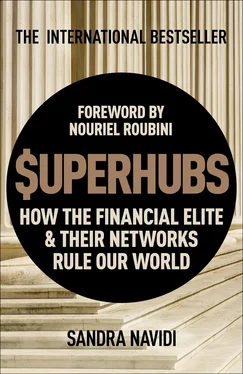Sandra Navidi - SuperHubs - How the Financial Elite and Their Networks Rule our World
Здесь есть возможность читать онлайн «Sandra Navidi - SuperHubs - How the Financial Elite and Their Networks Rule our World» весь текст электронной книги совершенно бесплатно (целиком полную версию без сокращений). В некоторых случаях можно слушать аудио, скачать через торрент в формате fb2 и присутствует краткое содержание. Год выпуска: 2017, Издательство: Hodder & Stoughton, Жанр: Старинная литература, на английском языке. Описание произведения, (предисловие) а так же отзывы посетителей доступны на портале библиотеки ЛибКат.
- Название:SuperHubs: How the Financial Elite and Their Networks Rule our World
- Автор:
- Издательство:Hodder & Stoughton
- Жанр:
- Год:2017
- ISBN:нет данных
- Рейтинг книги:4 / 5. Голосов: 1
-
Избранное:Добавить в избранное
- Отзывы:
-
Ваша оценка:
- 80
- 1
- 2
- 3
- 4
- 5
SuperHubs: How the Financial Elite and Their Networks Rule our World: краткое содержание, описание и аннотация
Предлагаем к чтению аннотацию, описание, краткое содержание или предисловие (зависит от того, что написал сам автор книги «SuperHubs: How the Financial Elite and Their Networks Rule our World»). Если вы не нашли необходимую информацию о книге — напишите в комментариях, мы постараемся отыскать её.
SuperHubs: How the Financial Elite and Their Networks Rule our World — читать онлайн бесплатно полную книгу (весь текст) целиком
Ниже представлен текст книги, разбитый по страницам. Система сохранения места последней прочитанной страницы, позволяет с удобством читать онлайн бесплатно книгу «SuperHubs: How the Financial Elite and Their Networks Rule our World», без необходимости каждый раз заново искать на чём Вы остановились. Поставьте закладку, и сможете в любой момент перейти на страницу, на которой закончили чтение.
Интервал:
Закладка:
The international consulting firm McKinsey played a major part in legitimizing ever-growing pay packages. One of their consultants, Arch Patton, conducted a study on executive compensation in the early sixties21 that was publicized in the Harvard Business Review. It received much attention and thereafter was revisited annually. This study provided rationalization and justification and, due to McKinsey’s wide global network of CEOs, spread and became “the law.”22
As David Mitchell points out in the Observer, one of the greatest skills top bankers possess is convincing us that they merit millions.23 Despite criticism, the assumption that “the higher the remuneration, the more qualified the executive” is deeply engrained in people’s minds and, barring a shareholder or social revolt, excesses will likely be reined in only very slowly, if at all.
Renumeration varies widely across industry lines—hedge fund titans make the most, followed by private equity kings. Both their remuneration is disproportionally higher than anyone else’s, because they charge substantial management fees in addition to success fees. Hence while their actual payout may vary wildly depending on performance, their downside is limited, because they receive the management fee regardless of performance. Bank CEOs earn significantly less, as they head publicly-listed companies with utility-like character, who to a large extent deal with financially so-called unsophisticated investors. Also, their job has more of a corporate management nature, rather than solely an investment management one. The twenty-five best-paid hedge fund managers in 2013 earned a total of $21.1 billion, in 2014 $11.62 billion, and in 2015 $12.94 billion.24 As the Guardian points out, the $1.7 billion that the two top earners, Kenneth Griffin of Citadel and James Simons of Renaissance Technologies, made in 2015, is equivalent to the annual salaries of 112,000 people at a minimum wage of $15,080. In fact, Simon’s earnings were so large in 2015 that if he were a country, it would rate as the world’s 178th most productive nation.25
In 2013, George Soros (net worth $24.9 billion) led the pack with an estimated $4 billion. Since converting his fund into a family office, he’s no longer included in the hedge funder compensation lists.
David Tepper (net worth $11.4 billion) of Appaloosa Management in 2013 made $3.5 billion, in 2014 $400 million, and in 2015 $1.4 billion. Bridgewater Associates’ Ray Dalio, in 2013 $600 million, in 2014 $1.1 billion, and in 2015 $1.4 billion.
Steve Cohen (net worth $12.7 billion), founder of SAC Capital, now renamed Point72 Asset Management, in 2013 took home $2.4 billion, in 2014 $2 billion, and in 2015 $1.55 billion.
John Paulson (net worth $9.8 billion), founder of Paulson & Co., in 2013 pocketed $2.3 billion, which was good for him, because in 2014 and 2015 he failed to make the list.
Jim Simons (net worth $15.5 billion), founder of Renaissance Capital, in 2013 earned $2.3 billion, in 2014 $1.2 billion, and in 2015 $1.7 billion.
In comparison, the titans of private equity made significantly less, though they will likely still be able to get by:
Steve Schwarzman (net worth $9.5 billion), cofounder of Blackstone, in 2013 made $374.5 million, in 2014 $690 million, and in 2015 $810.6 million. Leon Black (net worth $4.6 billion), founder of Apollo Global Management, in 2013 took home $369 million and in 2014 $331 million. Henry Kravis’s (of KKR, net worth $4.2 billion) pay in 2013 amounted to $327 million, in 2014 to $219 million, and in 2015 $165.1 million.
Bank CEOs are poor in comparison: In 2013 Jamie Dimon (net worth $1.1 billion), CEO of JPMorgan Chase, in 2013 and 2014 respectively made $20 million and in 2015 $37 million. Lloyd Blankfein (net worth $1.1 billion), CEO of Goldman Sachs, in 2013 received a total compensation of $23 million, in 2014 $24 million, and in 2015 $23 million. And Michael Corbat, Citigroup CEO, in 2013 received compensation valued at $17.6 million, in 2014 at $13.1 million, and in 2015 at $16.4 million.
Unsurprisingly, CEOs have not been known to oppose their ever-rising pay packages. An exception is James Gorman (net worth $50 million), Morgan Stanley’s CEO, who, in a 2012 interview with the Financial Times, lamented that compensation was too high and expressed sympathy with shareholders who viewed the industry as overpaid.26 Luckily for him, this seems not to have negatively impacted his 2013 pay, as it almost doubled from the previous year to a total of $18 million; in 2014 he made $22.5 million and in 2015 $21 million.
The “Flocking Effect”: The Superhub Habitat
Nowhere are the laws of network science more obviously reflected than in geography. Superhubs as a rule tend to cluster around one another. Like a swarm of birds, the titans of finance flock in the same direction and stay in close proximity. They live in the most expensive neighborhoods, in houses so enormous that they deserve their own zip codes. Living in the same areas, and even the same buildings, provides a sense of belonging, and by sticking with their kind, they de facto exclude those who are different. In line with the laws of network hierarchy, they often occupy the most centrally located houses or the top floors of metropolitan buildings—which tend to feature breathtaking panoramas of the city below. Trophy pieces of real estate in the “center of the center” are indispensable, because network location is one of the most visible signs of social status. The highest concentration of financiers in New York can be found on the Upper East Side close to Central Park; in Greenwich, Connecticut; in Bedford, Westchester County; and, of course, in the Hamptons on Long Island. While some more conservative financiers prefer “old money” New York addresses on Fifth and Park Avenue, others flock to the “newer” billionaire rows in Midtown. In the aggregate, those buildings literally house billions of dollars in personal wealth under one roof.
Private equity king Steve Schwarzman lives in one of the most pedigreed buildings in Manhattan: 740 Park Avenue. The magnificent limestone edifice, which sits on the corner of Park Avenue and 71st Street, has been home to many famous captains of industry. Its most spectacular feature is its storied history, which in a young country, is a hot commodity. Schwarzman is said to have paid $30 million in 2000 for an apartment that once belonged to John D. Rockefeller, a member of one of America’s most prestigious families. The triplex, which occupies the top three floors of the building, is equipped with twenty-four rooms, servants’ quarters, and every imaginable luxury. Other financiers who share the same address include hedge fund titans Israel “Izzy” Englander (net worth $5 billion) and David Ganek; the former CEO of CIT Group, John Thain; and Howard Marks (net worth $1.87 billion) of Oaktree Capital Management.
Among those who prefer Fifth Avenue to Park Avenue are hedge fund founders Marc Lasry (net worth $1.69 billion) of Avenue Capital Group, Glenn Dubin (net worth $2 billion) of Highbridge Capital Management, and legend George Soros. Soros resides in a sixteen-room duplex in a white-glove building on Fifth Avenue and 87th Street with gorgeous Central Park views. The seventh floor, with its sumptuous living and formal dining room area, is primarily for entertaining, while the personal rooms are located on the eighth floor. During the United Nations Week, many foreign dignitaries visit the building to make their overtures, much to the dismay of the neighbors, who must endure the inconvenience of having 87th Street blocked by barricades and hovering security details.
The price tag differs, but usually the top financiers spend upwards of $10 million on trophy real estate, with a few extra million allocated to renovation. A minimum of $100 million in liquid assets is required even to be considered as a potential buyer in these buildings, and financial records are scrutinized. But the price tag is not the only hurdle. The board, which functions as an admissions committee, is even harder to overcome. Many of Manhattan’s most exclusive buildings are cooperatives, which means that they operate like clubs, and residents decide whether or not applicants are deemed appropriate. According to the adage “money can’t buy you class,” many wealthy and well-known applicants have experienced embarrassing rejections.
Читать дальшеИнтервал:
Закладка:
Похожие книги на «SuperHubs: How the Financial Elite and Their Networks Rule our World»
Представляем Вашему вниманию похожие книги на «SuperHubs: How the Financial Elite and Their Networks Rule our World» списком для выбора. Мы отобрали схожую по названию и смыслу литературу в надежде предоставить читателям больше вариантов отыскать новые, интересные, ещё непрочитанные произведения.
Обсуждение, отзывы о книге «SuperHubs: How the Financial Elite and Their Networks Rule our World» и просто собственные мнения читателей. Оставьте ваши комментарии, напишите, что Вы думаете о произведении, его смысле или главных героях. Укажите что конкретно понравилось, а что нет, и почему Вы так считаете.












